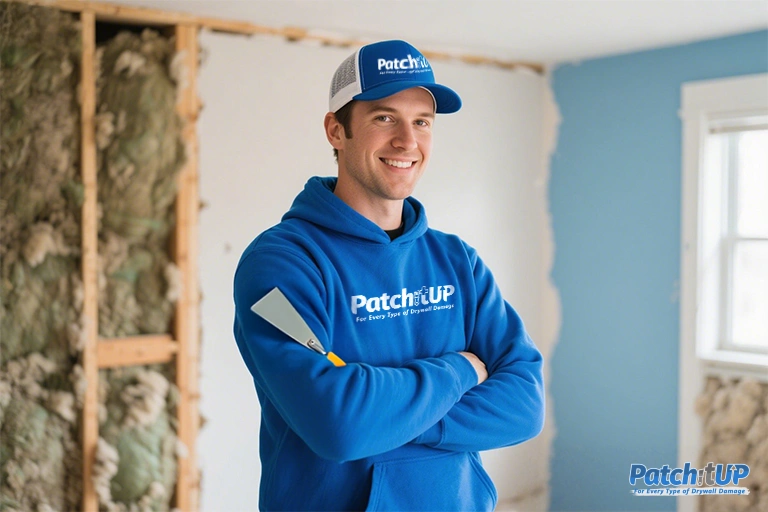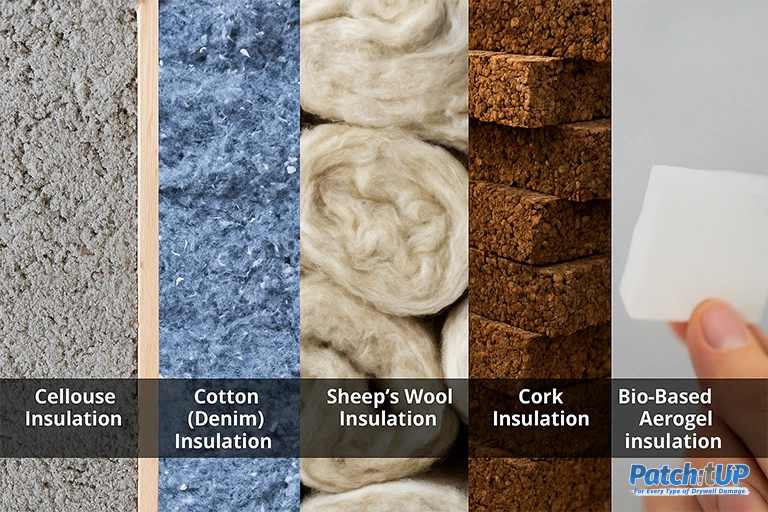Eco-Friendly Drywall and Insulation Materials!
Drywall & Insulation play a crucial role in sustainable building practices. As sustainability becomes a key priority in modern construction, eco-friendly materials are increasingly in demand. More builders, architects, and homeowners are choosing green alternatives to reduce environmental impact and promote healthier living environments.
In addition to improving indoor air quality and lowering energy consumption, a number of cutting-edge and environmentally friendly drywall and insulation options are available in 2025. This guide explores the most effective and eco-conscious drywall and insulation choices available today, along with tips to help you select the right materials for your home or building project.

What Does “Eco-Friendly” Really Mean?
- The term “eco-friendly” refers to drywall or insulation materials that are produced, used, and disposed of in a way that minimizes negative effects on the environment and human health. The following are important traits of eco-friendly materials:
- Recycled or renewable content: Materials made from post-consumer waste or natural, renewable sources.
- Low toxicity: Devoid of formaldehyde, volatile organic compounds (VOCs), and other dangerous substances.
- Energy efficiency: Materials that contribute to better thermal regulation, reducing heating and cooling costs.
- Durability and waste reduction: Long-lasting materials that generate less waste and require fewer replacements over time.
- Recyclability or biodegradability: Products that can be reused, recycled, or returned safely to the environment after their useful life.
Eco-Friendly Drywall Options in 2025
Drywall, or wallboard, is a standard material used in almost every modern building. The following options offer sustainable alternatives to traditional gypsum-based drywall:
1. Recycled Gypsum Drywall:
This drywall is made using recycled gypsum, often sourced from construction debris or manufacturing by-products. It offers the same structural performance as standard drywall but helps reduce landfill waste and resource extraction.
2. EcoRock Drywall:
EcoRock is made from over 80% post-industrial waste, including blast furnace slag. Unlike traditional drywall, it does not require high-temperature baking in kilns, which reduces energy consumption. It is naturally resistant to mold, fire, and termites, and it can be fully recycled.
3. Magnesium Oxide (MgO) Board:
MgO boards are fire-resistant, mold-resistant, water-resistant, and non-toxic. They are manufactured using magnesium oxide derived from natural minerals and do not contain any hazardous chemicals. MgO boards are ideal for high-humidity areas and provide excellent strength and durability.
4. Hempcrete Panels:
Hempcrete is made from hemp fibers mixed with a lime-based binder. It is carbon-negative, meaning it absorbs more carbon dioxide than it emits during its life cycle. Hempcrete panels provide excellent insulation, are breathable, and are fully compostable at the end of their life span.
Eco-Friendly Insulation Options in 2025
Choosing sustainable insulation is just as important as selecting eco-conscious wall materials. Here are the top insulation products that balance energy efficiency with environmental responsibility:
1. Cellulose Insulation:
Composed primarily of recycled newspaper and cardboard, cellulose insulation is treated with non-toxic fire retardants like borate. It has excellent thermal performance and is effective for soundproofing. It is also one of the most affordable green insulation options available.
2. Cotton (Denim) Insulation:
Made from recycled denim and other cotton textiles, this insulation is non-toxic and safe to handle without protective gear. It provides good thermal and acoustic insulation and is often treated to resist mold and pests. It is biodegradable and made from post-consumer waste.
3. Sheep’s Wool Insulation:
This natural option is renewable, biodegradable, and highly effective at regulating indoor humidity. Wool fibers can absorb and release moisture without losing insulating power, and they are naturally flame-retardant and mold-resistant.
4. Cork Insulation:
Harvested from the bark of cork oak trees, cork is a renewable and recyclable material. It provides excellent insulation and sound absorption, is resistant to moisture and pests, and does not emit harmful chemicals.
5. Bio-Based Aerogel Insulation:
Aerogels are advanced insulators known for their low thermal conductivity and lightweight properties. In 2025, manufacturers have begun producing aerogels from bio-based raw materials, making them more environmentally friendly. Although still more costly, they are ideal for projects requiring maximum insulation performance with minimal thickness.
Tips for Selecting Eco-Friendly Materials
When choosing drywall or insulation for a sustainable build, consider the following:
- Check certifications: Look for materials certified by organizations such as GREENGUARD, Cradle to Cradle, Energy Star, or Forest Stewardship Council (FSC).
- Avoid harmful chemicals: Choose products labeled as low-VOC or free from formaldehyde.
Choose local products: Sourcing materials locally can reduce transportation-related emissions.
Select durable, recyclable, or biodegradable products by taking lifecycle impact into account.
Climate-appropriate insulation: To optimize energy efficiency, choose insulation with the appropriate R-value for your area.
Final Thoughts:
Eco-friendly drywall and insulation materials in 2025 are smarter, more effective, and more more easily accessible than ever. In addition to lessening the environmental effect of your building or remodeling project, selecting products made from recycled, renewable, and non-toxic materials also creates healthier living spaces.
Whether you are building a new home or improving an existing one, making thoughtful material choices helps conserve natural resources, reduce energy use, and support long-term sustainability goals. With growing innovation in green building materials, there are now sustainable options to meet nearly every need, budget, and building standard.

FAQ For 2025 Guide to Eco-Friendly Drywall and Insulation Materials!
Q1: What insulation goes behind drywall?
A. Common options include fiberglass batts, cellulose, foam board, mineral wool, and spray foam insulation.
Q2: How does insulation affect the environment?
A. Insulation reduces energy use, which cuts greenhouse gas emissions, but some types may release pollutants during production or disposal.
Q3: What is the most environmentally friendly wall insulation?
A. Cellulose, sheep’s wool, cork, and recycled denim are among the most eco-friendly insulation choices.
Q4: Which eco-friendly insulation materials can be used in building construction?
A. Cellulose, cotton (denim), sheep’s wool, cork, hemp, and bio-based aerogel can all be used in sustainable construction.
Related Post :
- Top 5 Drywall Trends of 2025: Textures, Finishes & Soundproofing Solutions!
- DIY vs. Professional Drywall Repair: What’s Right for You?
- Plaster vs. Drywall: Which is Better for Your Walls?

Leave a Reply